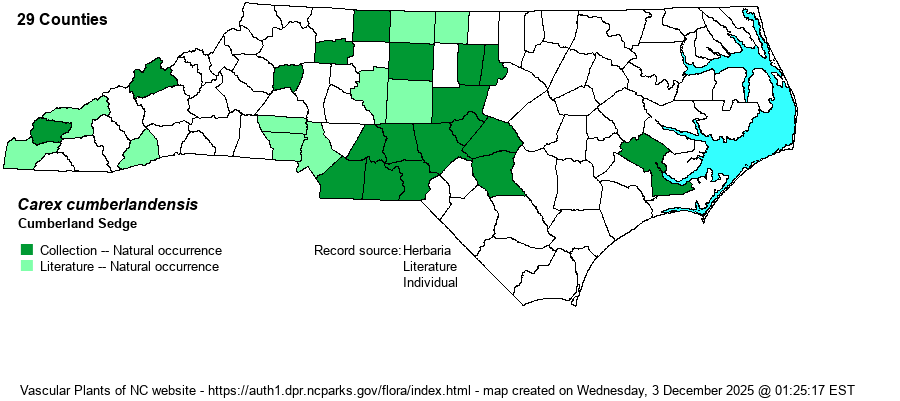| Author | Naczi, Kral, & Bryson | |
| Distribution | So far as is known, mostly in the Piedmont, rare in the Mountains and outer Coastal Plain. Absent from the Sandhills proper. The distribution of this recent split (2001) is not well known yet in NC.
Southwestern PA to southern IL south to central GA, eastern MS, western TN; disjunct in northwestern AR. | |
| Abundance | Believed to be uncommon in the lower Piedmont, and rare elsewhere. As mentioned above, the distribution and abundance of this species still needs clarification. | |
| Habitat | Mesic hardwoods and mixed pine-hardwoods, the soil circumneutral to slightly acidic. | |
| Phenology | Flowering and fruiting May-June. | |
| Identification | Cumberland Sedge is a small species growing from a cluster of rather long leaves; the plant is glaucescent. Perigynia and achenes are strongly 3-sided; the male spike is short and on a very short stalk. It is most similar to C. abscondita, but it has only 4-8 perigynia per spikelet (vs. 8-13 in that species) and perigynia are arranged distichously on the axis (vs. spirally in C. abscondita). | |
| Taxonomic Comments | Described in 2001, split off from Carex abscondita.
The genus Carex is the largest in North America, and among the largest in the world. In temperate and boreal regions, Carex is often the dominant or co-dominant ground layer in many habitats. Seeds (achenes) are valuable food for birds and small mammals, while foliage is used by birds and mammals to make nests and as food by mammals. Species of Carex often look vastly different from one another -- spikes erect vs. drooping, tiny inflorescence vs. whopping, culms leafy vs. naked, perigynia beaked vs. beakless, stems densely bunched vs. single, etc. The genus has been divided into many sections (or groups), based on shared characters; some taxonomists have suggested that these be different genera, but that proves unworkable (so far). All Carex share the feature of a perigynium (an outer covering) which completely surrounds the achene (seed). This covering may fit tightly or loosely (like a small bladder), depending on which group or species. Details of perigynia shape, ornamentation, presence and size of beak, number of striations (or veins) are all important ID features. In recent years Rob Naczi and colleagues have stressed the importance of arrangement of perigynia -- whether spiral (3+ ranks) or distichous (2-ranked) -- and have named a number of new species as well as split off some older synonyms. Therefore, RAB's (1968) key, excellent for its time, can only be used in a general way today. Members of some sections of Carex are difficult to key out (notably Ovales, Laxiflorae, Griseae); this is in part due to variation among individuals of a species, or failings of the key. FNA has drawings of most species and some species may be found in two or more places within a key, to acount for variability. New species to NC, and new to science(!), continue to be found in NC. | |
| Other Common Name(s) | None. The name is not a misnomer, as the center of its range is the Cumberland Mountains and Plateau in KY, TN, and AL. Nonetheless, the NC range is odd, with hardly any records so far from the mountains and Piedmont foothills. | |
| State Rank | S3? [S3] | |
| Global Rank | GNR | |
| State Status | | |
| US Status | | |
| USACE-agcp | | |
| USACE-emp | | |

